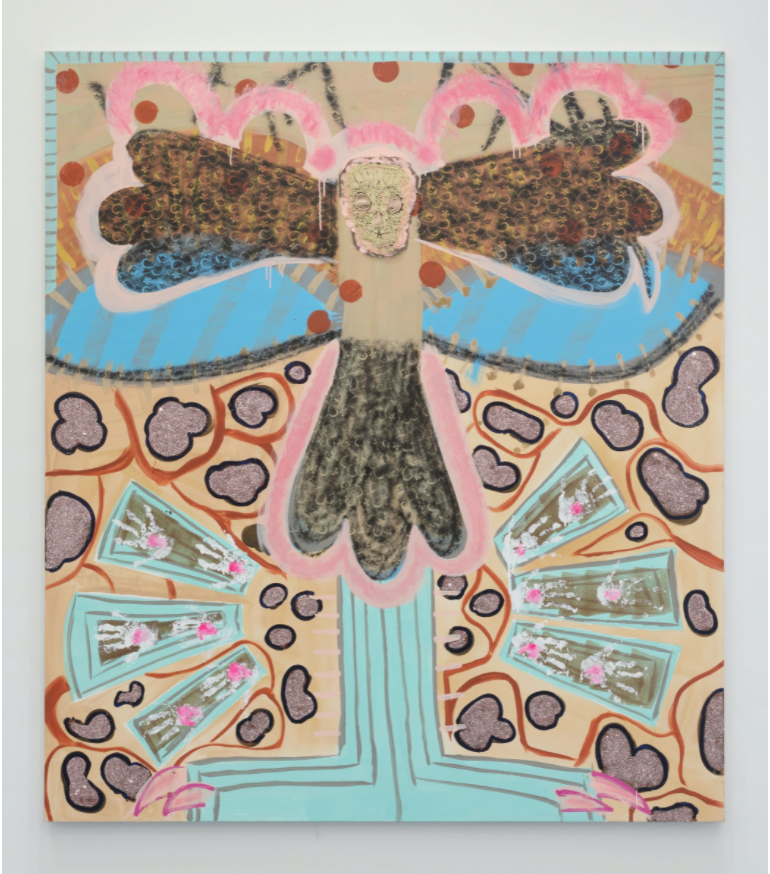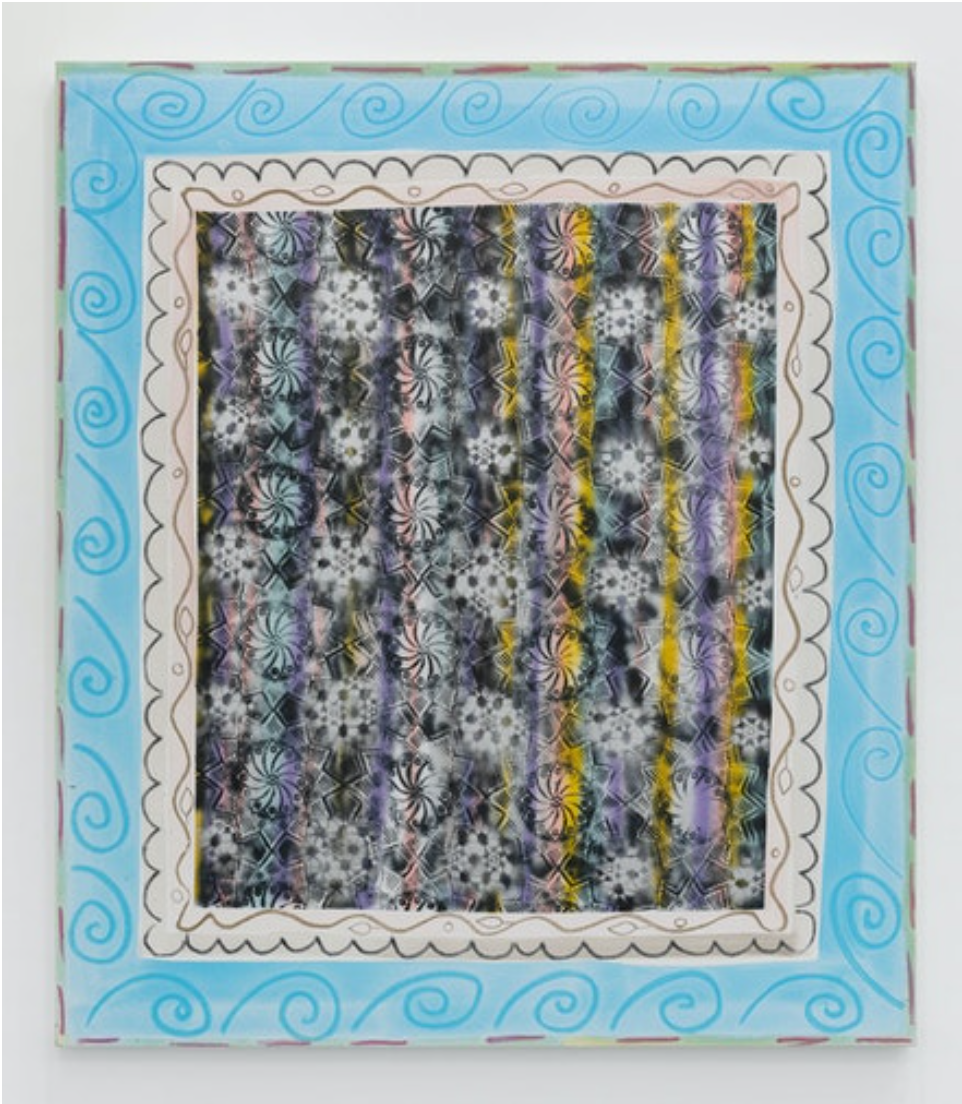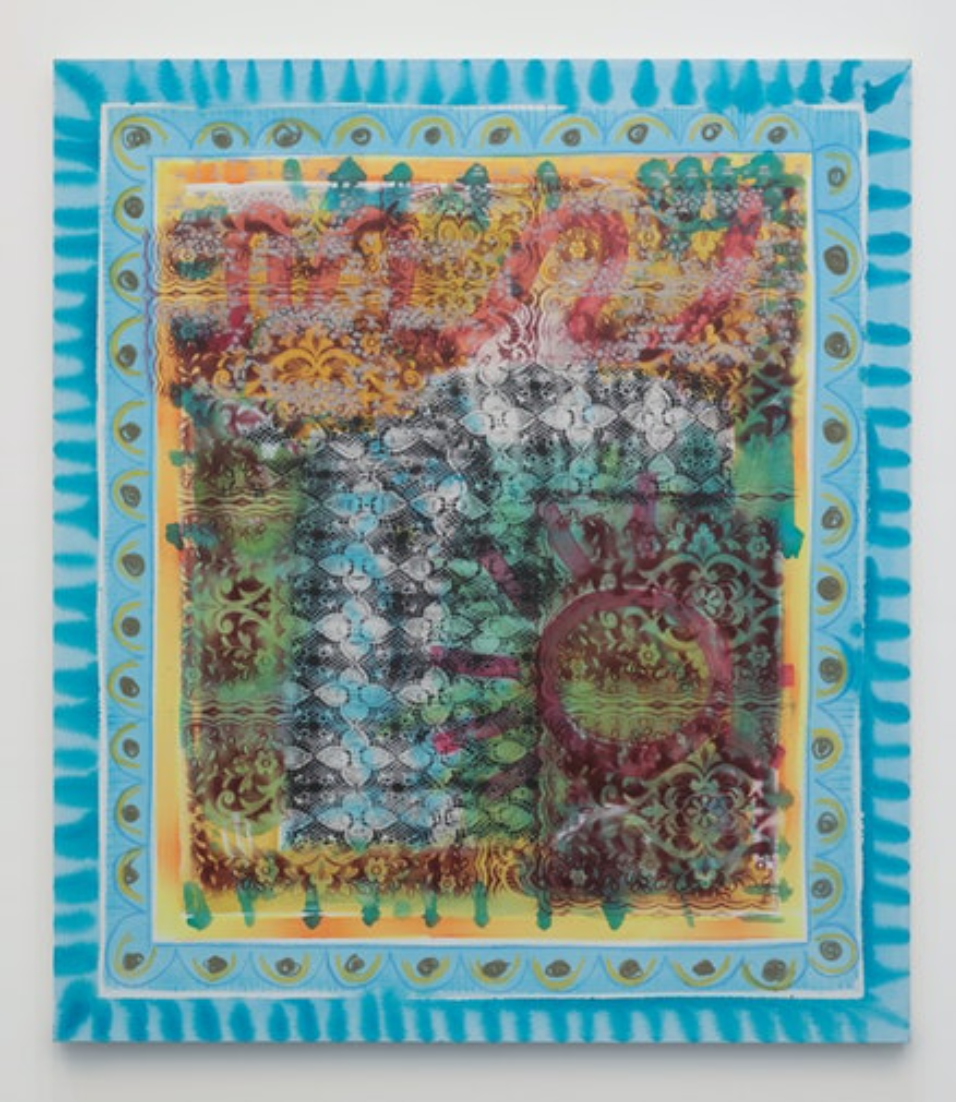
Tamara Gonzales has spent her life living, experiencing, understanding, and connecting with the indigenous cultures of the Americas, spiritual and ritual practices from India and the Caribbean, and with Magick, as well as undergoing healing journeys facilitated through psychedelic plant medicines, without forgetting her early years professionally decorating cakes while being immersed in counterculture and the punk music circles of the 1970s in New York. She has a personal desire to seek out and live with these marginalized and ancient cultures and rites that are often neither fully understood nor embraced in Western mainstream culture. We can recognize all of these experiences in Gonzales’s fourth exhibition at Klaus von Nichtssagend gallery. At the entrance, we are greeted by a large painting on the right wall that is as blue as Gonzales’s hair. In the main gallery are four large paintings (made with acrylic, spray paint, and pastel) and a wall with 32 small works on paper, two paintings, and two combines handsomely set into wooden boxes topped with sliding pieces of glass, laid flat on one table.

The two paintings Viral Starlight and Golden Dawn (both 2021) share the following characteristics: fluid acrylic washes of blocks of color, spray painted over lace stenciling, and pastel drawn motifs on canvas. In the former there are four receding rows of motifs: the first, thin fiery red dashes drawn on top of green lines; the second, spirals suggesting water; the third are bumps reminiscent of a child’s interpretation of airy clouds, but also the perforated border of a postage stamp; and last, the curvy branches of an earthbound plant and its sprouting leaves. These four elements frame a central abstract image, sprayed with black paint, evoking Arabic-like star patterns and spiral formations, painted over and across with vertical bands of alternating purple, pink, and aqua with the addition of yellow on the right side of the image. Together the stars, bursts, and vertical stripes emanate an abstract cosmic and vibrating sensation akin to an iconic and revered image framed with these simplified and graphic hand drawn scrawls. In Golden Dawn, Gonzales has deployed borders with different layers of motifs, all of which frame a central image made up of dark violet spray-painted over lace stenciling with both geometric shapes and floral patterns; these are layered with contrasting colors of acrylic washes in blues and golden yellows and oranges, which essentially bring warmth into the painting and suggest the glow of the painted pink outline of a sun placed in the lower right-hand corner. The blue becomes warm, sensual, and spiritual, akin to the blue skin of Hindu deities like Vishnu, symbolic of the infinite and immeasurable. Golden Dawn’s borders include a yellow-orange band, semicircles with dots suggestive of figurative breasts, the whiteness of bare canvas, and bleeding blue strokes perpendicular to the blue background. Patterns and repetition evoke both the decorative arts as well as a meditation practice where the process of craft is linked to a meditative or ritualistic process, the act of repetition invoking a state of trance. The other two large paintings Infinity Pool (2021) and Radioactive (2021) share similar pictorial treatments, enhancing the central image’s hierarchical importance for the viewer.
Lace most likely originated in the 15th century merchant town of Venice as a means to enhance luxury clothing and household items for men and women, signifying finesse and status; in Gonzales’s paintings and combines it seems to attribute power to the feminine by placing the lace patterns boldly front and center. Each combine box appears as an offering bearing turkey feathers wrapped with black ribbons and embroidered fabric that rest on top of patterned fabric flanked with a black lace trim. The wall of drawings is mostly done on handcrafted brown paper and drawn with colored pencil and dates from 2020–21. The images have similarities with the visual languages and sensibilities of Native American, Pre-Columbian, or Mesoamerican art, with subjects such as mermaid mythology, skulls, flora, snakes, and winged creatures emerging from her imagination, after experiencing plant medicines, or whilst traveling and on the move.

The fifth large painting, Hawk Moth (2021), is very different from the other works: here we can see an overt reference to Mexican and Haitian crafts with the central placement of a golden embroidered and pink sequined Calavera, evocative of the Mexican Día de los Muertos and the sequins from Haitian Vodou flags used in ceremonies. The centralized, symmetrical skull is superimposed over the moth-hawk creature, its wings spread out and defined by dark violet pigment spray-painted over a lace stenciling pattern outlined with thick pink painterly strokes. The top half of the painting is sprinkled with oversized terracotta dots hovering over what could be a blue body of water or portion of the sky in this beige landscape. The bottom half suggests a cool teal pedestal on which the moth is suspended upright like Christ on the cross; its base reveals large hawk nails with hot pink outlines. The whole painting thus exists in a sandy environment with glittery pink rocks floating around and many white handprints painted with hot pink stigmatas radiating from this mystical creature. Do we worship this creature, and is it protecting us? We can imagine how this work could be included in a ritualistic ceremony for initiations, in many of which Gonzales has herself partaken through her experiences with Kriya and Hatha yoga, Kanzo (Voudou), ayahuasca, and other practices.
For Gonzales, art is a form of healing. These rituals, ceremonies, and initiations unite both body and mind in ways that involve a more intense physical and mental participation, flexibility, and release that we can only imagine. The healing brought about from these experiences, and from her extensive traveling which informs her perception of the world and her place in it, perpetuates a flood of images that provides endless sources of birth and rebirth. Her work is bold, intuitive, and viscerally personal. We can feel the presence of a multi-faceted American culture, uniquely blending diasporic cultures, their knowledge, and their practices into our contemporary and immediate lives.